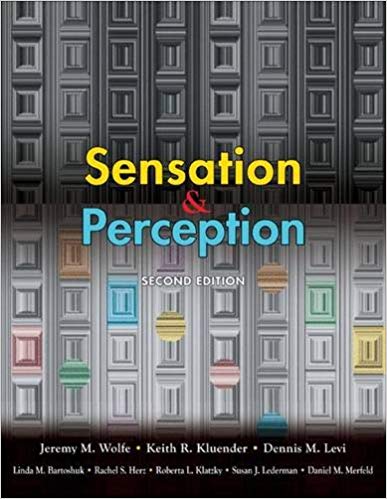Description
Sensation And Perception 2nd Edition By Jeremy M. Wolfe – Test Bank
hapter: Chapter 5: Essay
Essay
1. Explain whether one would display his or her luscious homegrown tomatoes under incandescent or fluorescent lighting in order to make them look their reddest and most succulent.
Ans: Tomatoes have about a 40 percent reflectance for all visible wavelengths above 600 nm and 0 percent reflectance for wavelengths below 600 nm. Incandescent light has its greatest intensity above 600 nm. The greatest intensity of fluorescent light is around 550 nm; spikes of high intensity are also observed at around 410 and 510 nm. That extra intensity above 600 nm will make the tomatoes look their reddest under incandescent light.
2. Going clockwise around the color circle, wavelength increases as you go from blue (450 nm) to cyan (500 nm), to green (550 nm), and so on. In between red (650 nm) and blue however, lies a quadrant of nonspectral purples. Are the wavelengths of these purples below 450 nm, above 650 nm, or something else altogether?
Ans: Nonspectral purples are so named because they do not exist as single wavelengths in the visible spectrum. These purple lights are mixtures of the shortest-wavelength violet and the longest-wavelength red. The nonspectral colors can only be created as mixtures.
3. A five-year-old girl has her heart set on having her room painted a bright shade of green. What is the drawback in simply mixing leftover supply of blue and yellow paint for this job? (Assume the paints are in perfect condition.)
Ans: Mixing paints is an example of subtractive color mixing. A mixture of blue paint and yellow paint subtracts all but the middle wavelengths (green light). The reflectance curve of a mixture of different-colored substances (green paint) is constructed by multiplying the reflectances of each substance in the mixture at each wavelength. As most substances have reflectance curves that fall well below 100 percent, subtractive mixtures typically reflect much less light than any of the constituent substances. Hence, it is likely that the green produced will not be as bright as the girl wants.
4. Can three primary colors ever be combined to produce a fourth color as highly saturated as the original three primaries? Explain why or why not, based on the color circle.
Ans: Primary colors are any three colors that can be combined in different proportions to produce a range of other colors. To predict the color of a mixture of three primaries, the colors must be connected to form a triangle in the color circle. The color of the mixture will fall somewhere within the triangle, depending on the relative intensities of the three colors. However, the three primaries will be incapable of producing a fourth highly saturated color as this saturated color will fall outside of the triangle in the color circle.
5. Explain the principle of univariance.
Ans: According to the principle of univariance, as it applies to cones, the absorption of a photon of light causes a fixed response by a cone, regardless of the photon’s wavelength. The strength of the response generated by a cone when it transduces light depends only on the amount of light (i.e., the number of photons) transduced, not on the wavelength of the light. Cones differ in the likelihood that they will absorb photons of light of a particular wavelength, but once a photon is absorbed, its effect is the same for all wavelengths.
6. If a spot of light is shown, is it possible to perceive whether one is viewing a single wavelength of light as opposed to multiple wavelengths superimposed on the same location? Explain why or why not.
Ans: It is not possible to directly perceive the difference between single versus multiple wavelengths of light on the same spot. Metameric color matching experiments have shown that the right mixture of three monochromatic primary colors is perceived as identical in color to some other monochromatic light. According to the principle of univariance, as it applies to cones, the absorption of a photon of light causes a fixed response by a cone, regardless of the photon’s wavelength. Hence, as long as the intensity of the single wavelength is the same as that of the multiple wavelengths on the same spot, the observer will be unable to perceive a difference, as identical responses will be generated by the photoreceptors in each case.

Reviews
There are no reviews yet.